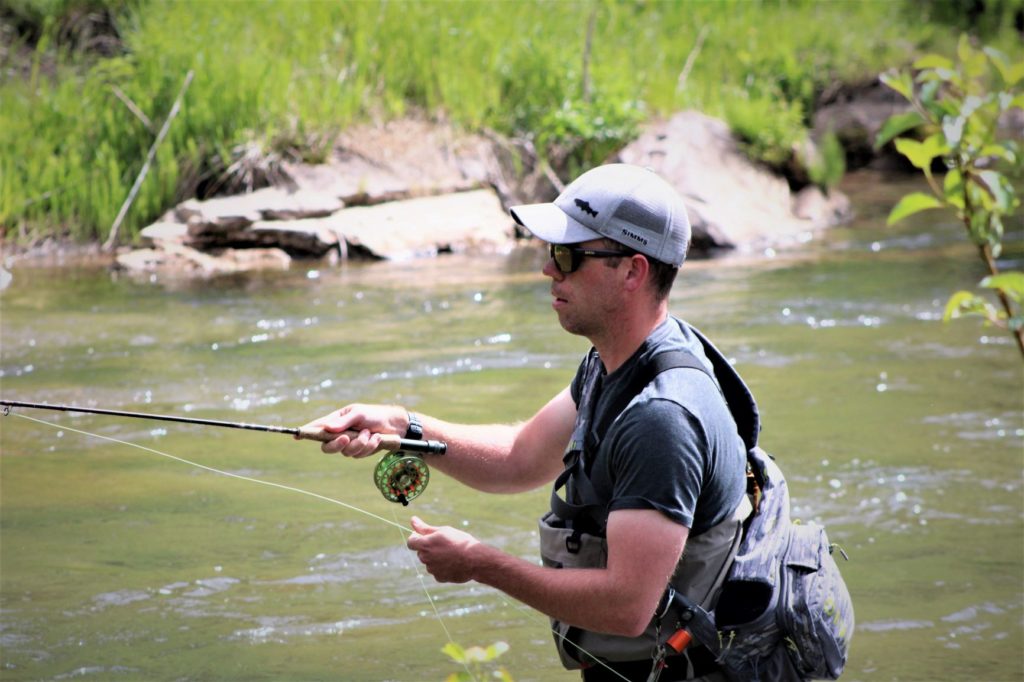
Dan Lane fly fishing on the Blacksmith Fork River on Thursday. He has also frequently fishes the Logan River
LOGAN – Dan Lane, a mechanical engineer who lives in Logan, was out working on his fly fishing skills on the Blacksmith Fork River Thursday afternoon.

Lane explains that he moved to Logan a year ago and has fly fished the Logan River. Recently, he has been using his skills to catch trout on the stretch of the Blacksmith Fork, below Hardware Ranch, where the water is clear.
Utah Division of Wildlife and Resources (DWR) Sportfish Coordinator Randy Oplinger, says that the Blacksmith Fork and Logan rivers are excellent places to sharpen fly fishing skills.
While social distancing due to COVID-19 is essential, fly fishing is a great recreational opportunity that offers space and a way to enjoy Utah’s outdoors. June is the best time of year for catching trout and whitefish.
“Fly fishing is probably one of the better ways to fish while social distancing,” Oplinger says. “Fly anglers tend to seek out fairly large patches of water to fish, so inherently there is good separation between anglers. Fly fishing is a great way to experience solitude while enjoying the outdoors.”
Utah fly fishing is great this time of year, since the spring runoff typically subsides this month, making it safer and easier to wade in the streams. Cutthroat trout also spawn during the peak of the runoff and are especially hungry due to spawning.

Fly fishing can also become competitive. The Utah Cutthroat Slam, launched in 2016, provides a fun challenge and a great way to get outdoors. The goal of the Slam is for anglers to catch each of the four native Utah cutthroat trout — Bonneville, Colorado River, Bear River and Yellowstone — in their historic ranges.
Registration costs $20 for adults and $10 for youth. You can register on the DWR website. All but $1 of the registration cost is dedicated to conservation projects that help Utah’s native cutthroat trout. Participating anglers have raised more than $42,000. Those conservation projects have helped improve cutthroat trout habitat throughout Utah, and the funding has also been used to educate the public about the fish species.
“Streams often hit optimum temperatures during June, which increases the fish’s metabolism rates, making it so they need to eat a lot,” Oplinger says. “That works out well for anglers because it means the fish are looking for food and are more likely to take a fly, which makes for hot fishing.”

Oplinger says cutthroat are a lot of fun to fish because they fight hard and are difficult to catch, giving anglers an added challenge.
“Cutthroat are Utah’s only native trout species, and at one point, there were virtually no cutthroat trout in Utah and they were on the verge of being listed under the Endangered Species Act,” Oplinger says. “We’ve worked hard to restore cutthroat trout in their native ranges throughout the state because they are an important part of the natural ecosystem in Utah.”
DWR reports that the Logan River has one of the highest cutthroat trout densities documented in Utah. The river also offers Bear River cutthroat, as well as brown trout and mountain whitefish. Blacksmith Fork River also has some great cutthroat trout, rainbow trout and whitefish.

“It is always a good idea to fish with someone else and to have the right equipment to help keep you safe,” Oplinger says. “Good wading boots can give you better grip and prevent you from slipping. Make sure to use good judgment before entering any flowing water.”
For more information about how to participate in the Utah Cutthroat Slam go to the DWR website.

